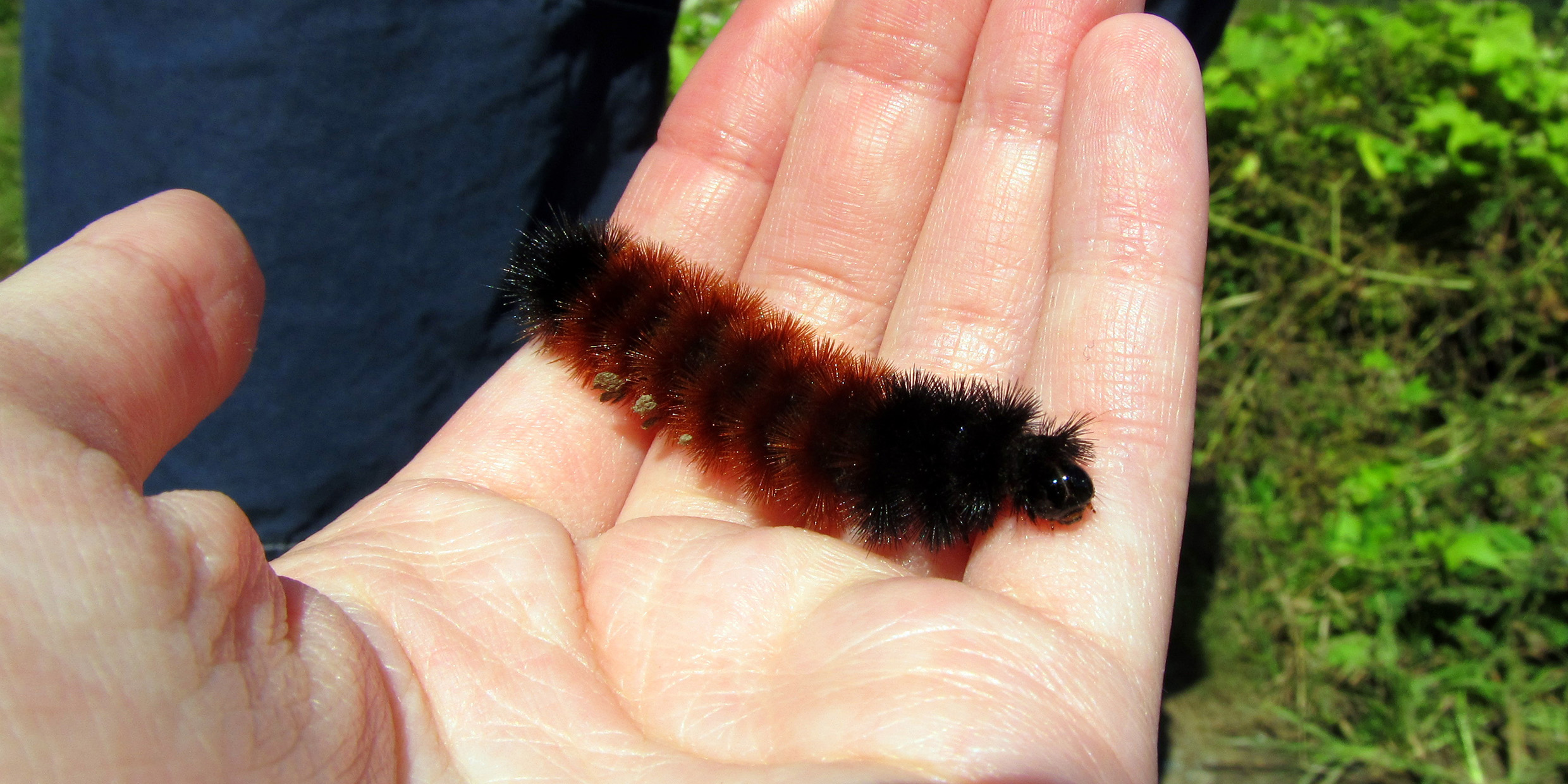Originally published 31 October 1994
Woolly bears are on the march. Double time. Making tracks. Trucking.
They really move, along the sidewalk, across the path, at a typical speed of a yard-a-minute — supersonic for a caterpillar — on 16 little legs (or what pass for legs) hidden in their brushy hair. Where are they going?
The guidebooks say if you see a woolly bear in the path in the fall, it is looking for a secure place to spend the winter — under leaves, inside a log, behind a loose clapboard. Then why do we so often see them on open paths, barreling along in the same direction we are going, as if late for an appointment or out for a jog?
They’ll get to their hidden resting places sooner or later, for I’ve occasionally found them in January or February curled up under leaves or logs like sleeping kittens, snoozing the winter away in frozen slumber. The naturalist Edwin Way Teale described the tightly curled woolly bears as dozing doughnuts.
But the search for a suitable wintering place can’t explain the caterpillar’s October predilection for sidewalks, roads, and open spaces. Even a half-blind bug with a pinpoint brain can tell smooth asphalt from a place that is likely to have cozy nooks and crannies.
I’ll tell you what the woolly bears are doing. They are doing the same thing we are doing. Enjoying these last warm days of autumn. Taking the air. Stretching their limbs.
Whenever I meet someone jaded with life, forgetful of mystery, bored out of their minds, I pick up a woolly bear and place it in their palm. An inch-and-a-half of slippery fur. A walking mustache. Two bulging eyes (or what pass for eyes) in there among the bristles, the only way to tell which end is going and which is coming.
This slip of cuteness — for, yes, they are cute, a favorite pet of children, worthy of a place in the teddy bear stores — this fragile slip of cuteness survives New England’s deep freeze, one of the hardy insects that winter over in the larval stage. In spring, it wakes, has a bite to eat, then rolls itself into a pupa, using its hairs to make the cocoon, lacing them together with silk. Two weeks later, an Isabella tiger moth emerges, presto-chango, like a magician’s trick.
A black-and-brown woolly bear goes into the box — a wave of the wand — a yellow-winged tiger moth emerges. Somehow, the creature has managed to remake itself, rearranging its atoms, from crawling fuzzball to airborne angel.
In few insects is the transformation so stunning, so complete. An insatiable leaf-eating machine becomes a sex-obsessed nectar-sipper. Shape, color, internal organs, mode of transportation — all changed. It’s as if an elephant became a swan, or a rattlesnake became a parakeet.
Of course, the totality of the transformation is to some extent illusory. What remains constant through all the stages of metamorphosis is information. It’s all there, at the heart of every cell, in the DNA, blueprints for making a woolly bear and a tiger moth.
There are clusters of cells in the larval caterpillar that are destined to become anatomical features of the adult moth, dormant, awaiting a chemical signal that will make them surge into activity. The warmth of spring releases hormones from glands in or near the brain. These cause the caterpillar to build a chrysalis and begin metamorphosis.
Previously dormant adult cells begin to multiply. They take their nutrients from superseded larval cells, which are transformed into a kind of nutrient soup for the benefit of the growing adult organs. The woolly bear’s six stumpy front feet are turned into the tiger moth’s slender legs. Four bright wings develop, as do reproductive organs. Chewing mouth parts become adapted for sucking. In two weeks, the rearrangement of atoms is complete. The chrysalis breaks.
There’s no way to think about this without gasping for breath. It’s one thing to understand the biology, at least that part of it that we know something about: DNA, hormones, gene expression, and all that. But knowing the biology only makes the metamorphosis all the more breathtaking.
Not magic at all, but a fierce, inextinguishable force driving the
universe, Dylan Thomas’ “green fuse,” permeating every atom of matter, soaking nature the way water soaks a sponge. Call it life, call it God, call it an inch-and-a-half of black and brown fur. It can’t be ignored when you hold it curled in your hand, a gram of divinity.
Lift it gently from the palm, taking care not to let it slip between your fingers. Place it again on the sidewalk. The larva of the Isabella tiger moth slowly uncurls, lifts its head (ah, so that’s the anterior end), takes a nearsighted gaze around (or is it a sniff?), then scurries off again in its headlong dash for who-knows-what, a many-footed distillation of the Heraclitean fire that animates the world, hell-bent-for-caterpillar-leather under October’s golden sun.



